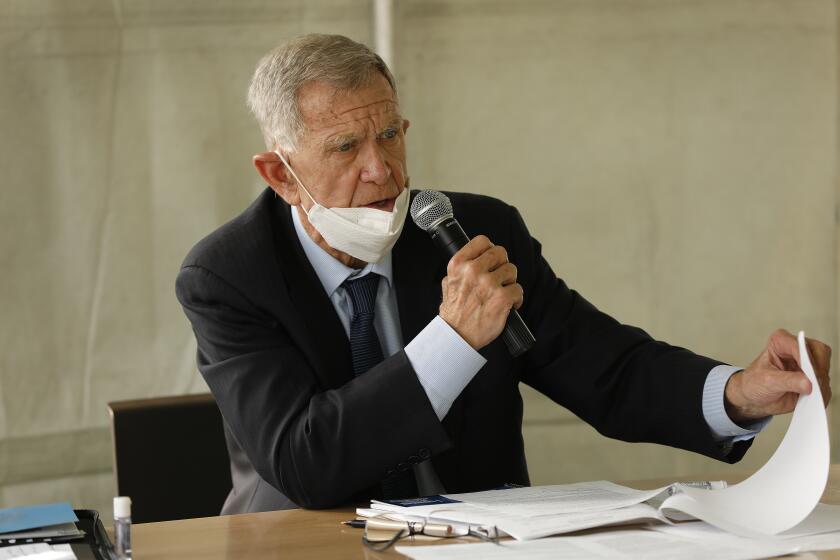Red light camera roulette: L.A. is money loser, Culver City rakes it in
- Share via
When it comes to collecting traffic ticket revenue from red light cameras, Culver City has been king in Los Angeles County.
The city generated nearly $2 million in photo ticket fines in the last eight months -- hundreds of thousands more than Los Angeles, which had cameras at twice as many intersections, according to new government estimates obtained by the Los Angeles Times.
And although Culver City makes money, Los Angeles’ photo enforcement program is running in the red and may never recover about $2 million in construction costs and past deficits, records and interviews show. In addition, Los Angeles officials recently reported that they overpaid their red light camera contractor by more than $500,000.
Critics say that red light cameras -- hailed for reducing deadly collisions at the intersections they monitor -- have essentially become ATMs for local governments, issuing citations around the clock that can cost up to $400.
But a Times review of more than two dozen systems in Los Angeles County found sharply mixed financial results. Some officials also acknowledge that because camera ticket revenue flows through a labyrinth of court and county agencies, it is hard to precisely gauge how much cash their systems generate.
Some cities, including Walnut, Santa Clarita and Montebello, have netted tens or even hundreds of thousands of dollars above camera operating costs, officials say. Culver City could clear even more this year, based on budget documents and recent revenue estimates.
Yet Paramount shut down its camera program in 2006 after running a projected $178,000 deficit in two years.
“It just really wasn’t what we thought it would be,” said Assistant City Manager John Moreno.
Compton also canceled its program because of concerns over costs.
The reasons for the financial differences can include varying traffic volumes, citation and collection rates, as well as drivers adjusting their behavior, officials say.
Pasadena’s 6-year-old camera program has produced safety benefits, including reductions in red light running, but it is struggling to cover contractor costs, said Norman Baculinao, the city’s senior traffic engineer.
“You have less violations, you have less revenue,” he said. “We’re at that point now: Our violations are barely making the monthly fees.”
Protecting motorists and pedestrians -- not filling public coffers -- is the point of red light cameras, backers argue. In addition, cameras help reduce serious accidents, which saves money and frees up officers for other duties, police say.
Most of the cash generated by red light cameras goes to state and county agencies, along with private contractors who install and maintain the systems, and process violation data for police to review. Cities receive less than half the ticket fines and from that typically pay the vendors $4,000 to $6,000 per month per intersection approach monitored.
Culver City’s program will cost about $1.5 million this fiscal year in fees and personnel, according to the city budget. But for the last eight months alone revenue has exceeded that cost by about $400,000. Additional legal costs are not included in those calculations, said police Lt. Manuel Ariza. Still, he acknowledged: “The city doesn’t break even or lose. . . . It makes money at end of the year.”
Tickets and revenue are boosted partly because of the city’s location, near the heart of the Westside’s busy 405 Freeway, he said.
In Los Angeles, contractor Nestor Traffic Systems is paid about $2.5 million a year -- about 80% of the red light program’s annual costs, records and interviews show. The remaining expense is for Los Angeles Police Department officers who approve photo tickets and appear at traffic court trials.
Based partly on revenue projections supplied by Nestor, city analysts had predicted that the program would break even this summer, if only in terms of ongoing costs. But new estimates prepared by Los Angeles County Superior Court, which processes traffic tickets, indicates that Los Angeles’ red light camera income is falling short of expectations, possibly by tens of thousands of dollars a month, according to the city budget office.
“Based on the court figures, we’re not covering costs,” said a city financial analyst familiar with the program. He said superiors authorized him to speak with The Times but not to be quoted by name.
One problem has been that citation rates have been lower than expected. Payments to Nestor are supposed to be reduced if citations do not meet an agreed-upon threshold. A recent Police Commission review found that citation rates fell below that level in 2006 and 2007, and that the city overpaid the firm more than $500,000.
The city has recouped the funds by withholding payments, but the company disputes the action and hopes to negotiate a settlement, said Nestor’s general counsel, Brian Haskell.
The city also gets less photo enforcement revenue because the vast majority of its camera tickets are for rolling right turns. As issued by the city, those tickets carry a $159 fine and the city gets back about $58. In other jurisdictions, all photo tickets cost $381, not counting traffic school, and those cities receive $150 to $160 on each citation.
Los Angeles officials still hope that their red light cameras will cover future operating costs. But LAPD Sgt. Matthew MacWillie said: “This is a traffic safety program. The intent is not to raise money.”
Promises of sizable red light camera profits were a part of a vendor’s pitch to at least one city, records show.
South Gate officials were told they could reap an estimated $600,000 to $1.5 million in “annual net profit” from photo enforcement, according to a copy of a confidential memo by Redflex Traffic Systems obtained from the city.
A Redflex spokeswoman said she could not comment on the South Gate proposal. But cities often seek assurances that camera systems will be self-supporting and not require additional public funding, said Cristina Weekes, Redflex vice president of marketing.
Six years later, South Gate officials are reexamining the safety and financial performance of their camera program but have not decided whether to renew the contract, said city Finance Director Julia James.
For James and fiscal officials in other cities, red light camera financing has been frustratingly fuzzy.
The county court system combines red light camera funds due cities with fines and bail forfeitures from all other types of cases -- making photo ticket dollars difficult to identify or audit.
“This has been a thorn in my side,” said Joyce Rooney, a transportation manager in West Hollywood.
Because of such complaints, court administrators in September began producing estimates of what cities should receive each month from their camera systems, based on monthly snapshots of payments actually made on photo tickets. Though not precise, authorities say the figures are the best measure available of red light camera revenue going to cities.
Still, the Los Angeles budget analyst said, “It’s impossible for us to know exactly how much money we’re getting.”
More to Read
Sign up for Essential California
The most important California stories and recommendations in your inbox every morning.
You may occasionally receive promotional content from the Los Angeles Times.










